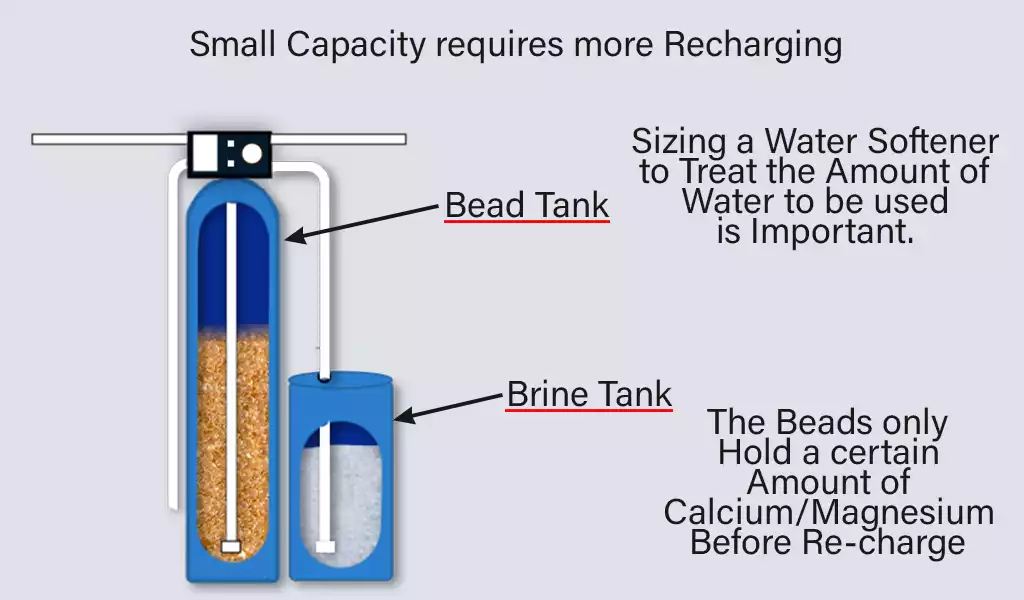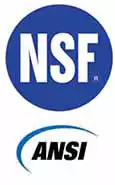
Efficiency
Part 1 of this Series Explained How a Water Softener removes the Calcium & Magnesium (Hardness), from Your Water.
The Resin Beads Hold the Hardness until you Rinse them with Sodium Water from the Brine Tank.
The Water Softener Industry Standard for a 32,000 Grain Capacity Unit will have 1 Cubic Foot of Resin Beads. You should Calculate the Size needed for a Softener, 32,000 Grain could easily be too Small for a Family of 6. see Sizing below.
Efficiency is, How much Salt is used to Remove the Hardness Grains from the Resin Beads. The Amount of Waste Water used is also part of the Efficiency Requirement.
NSF and ANSI (see below) Have set Standards for Efficiency (NSF/ANSI 44), 1 pound of Salt will efficiently remove 4,000 Grins of Hardness in a Regeneration Cycle.
Some States and Parts of Canada require the Manufacture to Print the Efficiency in Grains removed per Pound of Salt.
Manufactures Test their Product for Certification in a Laboratory Environment that may not be the Same at your Home.
Most recommend only purchasing a Water Softener that is certified to the NSF/ANSI 44 Performance Standard. Note: Fine Mesh Resin Beads have more Combined Surface Area for ion Exchange.
Regeneration Cycles can be Manual, Timed or based upon Monitoring Water Used. Manual or Timed Regeneration are not recommend for Efficient Operation.
Regeneration should be Performed only when the Resin Bead Capacity is at a level that can be Efficiently Rinsed with the least amount of Salt and Water (Metered). Our Examples are based upon 75% and 80% Capacities.
Sizing
Determining the Proper Size for a Water Softener (Grain Capacity) you need to gather some local Information and follow the Steps below.
Gallons per Day per Person
How much Water is used based upon a Daily Average Gallons per Day per Person (AGPD). Determining a Number for your Household Depends on many Factors, 100 AGPD is an average from 3 Governmental Websites.
Using 100 AGPD could vary a little, for Instance if you have 3 Teenagers it could easily be more. A Retired Couple living in a Condo it could be less, you decide.
Using your Utility Water Bill and Dividing by the Number of Persons is not Recommended. Your Utility Bill shows Total Gallons Used that includes water for Landscaping, Swimming Pool, Washing the Car etc.
Multiply your AGPD by the Number Persons in your Home.
Our Example will use 100 AGPD in a 4 Person Household.
Water Hardness
Contact your Utility Provider or go to their Website, for the Hardness Value Most Water Utilities provide a Range of Hardness, it's not always the same Day in and Day out, determine the Average.
The Hardness value should be in Parts Per Million (PPM). Use this Chart below if you need to convert from Grains per Gallon.
Hardness Classes
Soft Water
- Less than 1.0 Grains per Gallon
- or Less than 17 PPM, Parts per Million
Low Hardness
- 1.0 - 3.5 Grains per Gallon
- or 17 PPM - 60 Parts per Million
Moderate Hardness
- 3.5 - 7.0 Grains per Gallon
- or 60 - 120 Parts per Million
Hard
- 7.0 - 10.5 Grains per Gallon
- 120 - 180 Parts per Million
Very Hard
- Higher than 10.5 Grains per Gallon
- More than 180 Parts per Million
Our Examples will use 180 ppm Hardness or 10 Grains
Family of 4 Calculations 32,000 Grain Capacity
100 AGPD times 4 Persons = 400 Gallons per Day times 10 Grain Hardness = 4,000 Grains. Multiply that number by 7 days = 28,000 Grains.
If your 32,000 Grain Softener is set to Regenerate at 75% of Capacity it will Regenerate at approximately 24,000 Grains or 6 Days. Using the NSF/ANSI 44 Standard you will use 6 pounds of Salt per Regeneration.
In a 2 Month Period you Should be Regenerating 10 Times using 60 Pounds of Salt. Normal Bag Size of Salt is 40 pounds or 1 1/2 Bags every 2 Months.
Using the Same Numbers except for a Regeneration setting at 80% Capacity you will Regenerate at 25,600 Grains Hardness in just under 7 days using 6.4 pounds of Salt.
In a 2 Month Period you Should be Regenerating just over 9 Times using about 57 Pounds of Salt. No advantage in using 80% Setting.
Family of 6 Calculations 32,000 Grain Capacity
100 AGPD times 6 Persons = 600 Gallons per Day times 10 Grain Hardness = 6,000 Grains per Day. Multiply that number by 7 days = 42,000 Grains a much higher number.
If your 32,000 Grain Softener is set to Regenerate at 75% of Capacity it will Regenerate at approximately 24,000 Grains or 4 Days. Using the NSF/ANSI 44 Standard you will use 6 pounds of Salt per Regeneration.
In a 2 Month Period you Should be Regenerating 15 Times using 90 Pounds of Salt. Normal Bag Size of Salt is 40 pounds or 2 1/4 Bags every 2 Months.
Using the Same Numbers except for a Regeneration setting at 80% Capacity you will Regenerate at 25,600 Grains Hardness in about 4.3 Days using 6.4 pounds of Salt per Regeneration.
In a 2 Month Period you Should be Regenerating about 14 Times using about 90 Pounds of Salt 2 1/4 Bags.
Family of 6 Calculations 48,000 Grain Capacity
100 AGPD times 6 Persons = 600 Gallons per Day times 10 Grain Hardness = 6,000 Grains per Day. Multiply that number by 7 days = 42,000 Grains.
Your 48,000 Grain Softener is set to Regenerate at 75% of Capacity it will Regenerate at approximately 36,000 Grains or 6 Days. Using the NSF/ANSI 44 Standard you will use 9 pounds of Salt per Regeneration.
In a 2 Month Period you Should be Regenerating about 6 1/2 Times using about 60 Pounds of Salt 1 1/2 Bags.
This approximately 3/4 of 1 Bag less every 2 months or 4 1/2 Bags per year. In 10 Years you would Saving 45 Bags of Salt.
Consider the Cost Difference between the 2 Sizes used in our Examples. Another Consideration would be Convenience, 4 1/2 Bags each year you don't Carry Home and Dump into the Brine Tank.
A Straight Forward Comparison, your Situation may have some Variables to factor in. We did not include Iron Deposits you may have. If you have High Iron in your Water you may want to have a local Professional do the Calculations for you.
 (NSF) The National Sanitation Foundation, an Independent third-party certification body that tests and certifies products to verify they meet these Public Health and Safety Standards. The (NSF) The National Sanitation Foundation has Established Standards and Protocols for the Safety and Performance of Filters, Purifiers and Reverse Osmosis Systems. (See Link Below to Wikipedia understanding the NSF)
(NSF) The National Sanitation Foundation, an Independent third-party certification body that tests and certifies products to verify they meet these Public Health and Safety Standards. The (NSF) The National Sanitation Foundation has Established Standards and Protocols for the Safety and Performance of Filters, Purifiers and Reverse Osmosis Systems. (See Link Below to Wikipedia understanding the NSF)
(ANSI) The American National Standards Institute (ANSI) is a private, non-profit organization that administers and coordinates the U.S. voluntary standards and conformity assessment system.
Comment Below
Internal Links
Like this Article, you can give us a Thumbs just click on the Icon. It's anonymous and we will Thank You.

“An architect's most useful tools are an eraser at the drafting board and a wrecking bar at the site”
Frank Lloyd Wright
© Copyright 2023 YPRemodel.com. All rights Reserved. This material may not be Published, Broadcast, Rewritten or Redistributed without written Permission.
